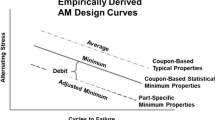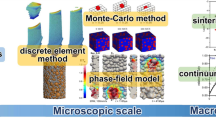Abstract
Direct laser metal deposition (DLMD) is a modern powder-fed additive manufacturing process, which builds up complex objects layer by layer, providing a potential capacity to produce key structural components specifically for the aerospace industry. The printing process is of a multidisciplinary nature, and has gained increasing attention in the areas of engineering mechanics, material science, control engineering and many other related fields. The quality control of the printed part depends on a large number of process parameters. The aim of this work, therefore, is to develop a coupled finite element and multiphase field framework, that provides an effective way to understand the quantitative relationship between the process parameters, temperature history, thermally-induced residual stresses and microstructures in the DLMD process. More specifically, the established multiscale framework is able to sequentially couple the heat transfer, metal melting/solidification, and stress analysis to simulate the macroscopic temperature distribution, thermal residual stresses and dendrite growth and solute segregation in a thin wall structure made of a binary nickel-copper alloy. The latest simulation technologies are used to model the process of progressive material deposition as well as the movement of the laser beam. It has been found that the high intensity laser introduced in DLMD can produce a complex thermal history and a significant level of thermal residual stresses and distortion. Microstructure predictions demonstrate the location-dependent morphology evolution, e.g., the dendrite spacing and the degree of solute segregation, attributed to the spatially variant temperature history.








Similar content being viewed by others
References
C.L. Weber, V. Peña, and M.K. Micali, IDA Paper 5091, (2013).
J. Ning and S. Liang, J. Manuf. Mater. Process. 2, 37 (2018).
J. Ning and S. Liang, Materials 12, 284 (2019).
A.J. Pinkerton and L. Li, Proc. Inst. Mech. Eng. Part C 218, 531 (2004).
A. Vasinonta, J.L. Beuth, and M. Griffith, J. Eng. Ind. 129, 101 (2006).
J.C. Heigel, P. Michaleris, and E.W. Reutzel, Addit. Manuf. 5, 9 (2015).
R. Gardon and J.C. Akfirat, Int. J. Heat Mass Transfer 8, 1261 (1965).
K.P. Perry, Proc. - Inst. Mech. Eng. 168, 775 (1954).
A.F.A. Hoadley and M. Rappaz, Metall. Trans. B 23, 631 (1992).
R. Gardon, and J. Cobonpu, Heat transfer between a flat plate and jets of air impinging on it, in International Development in Heat Transfer, Proceedings of Heat Transfer Conference (1962), p. 454.
S. Ghosh and J. Choi, J. Laser Appl. 17, 144 (2005).
Y. Fu, J. Michopoulos, and B. Gnanasekaran, Comput. Mater. Sci. 155, 457 (2018).
Y. Fu, J.G. Michopoulos, and J.-H. Song, J. Comput. Sci. 20, 187 (2017).
J.H. Song, Y. Fu, T.Y. Kim, Y.C. Yoon, J.G. Michopoulos, and T. Rabczuk, Int. J. Mech. Mater. Des. 14, 491 (2018).
A. Almasi, A. Beel, T.Y. Kim, J.G. Michopoulos, and J.H. Song, J. Eng. Mech. Div. Am. Soc. Civ. Eng. 145, 0401908282 (2019).
G.R. Liu, and S.S. Quek, The Finite Element Method: A Practical Cours, 2nd edn. (Elsevier (BH), 2014), p. 464.
J. Eiken, B. Böttger, and I. Steinbach, Phys. Rev. E 73, 066122 (2006).
M.K. Thompson, G. Moroni, T. Vaneker, G. Fadel, R.I. Campbell, I. Gibson, A. Bernard, J. Schulz, P. Graf, B. Ahuja, and F. Martina, CIRP Ann. 65, 737 (2016).
M.K. Thompson, A. Stolfi, and M. Mischkot, CIRP J. Manuf. Sci. Technol. 12, 25 (2016).
G. Marion, G. Cailletaud, C. Colin, and M. Mazière, A finite element model for the simulation of direct metal deposition, in ICALEO (2014).
Abaqus, Dassault Systèmes Simulia Corp., (2019).
G.R. Liu and N.T. Trung, Smoothed Finite Element Methods (Boca Raton: CRC, 2010).
S. Kim, W. Kim, T. Suzuki, and M. Ode, J. Cryst. Growth 261, 135 (2004).
S.G. Kim, W.T. Kim, and T. Suzuki, Phys. Rev. E 60, 7186 (1999).
J.J. Valencia, and P.N. Quested, Thermophysical properties, in Casting, (New York: ASM International, 2008), p. 468–481.
R.E. Pawel and E.E. Stansbury, J. Phys. Chem. Solids 26, 607 (1965).
C.Y. Ho, M.W. Ackerman, K.Y. Wu, S.G. Oh, and T.N. Havill, J. Phys. Chem. Ref. Data7(3), 959 (1978).
G.R. Liu, Comp. Struct. 40, 313 (1997).
D. Jeong and J. Kim, Phys. A 442, 510 (2016).
J. Li, J. Wang, and G. Yang, J. Cryst. Growth 309, 65 (2007).
M. Asta, J.J. Hoyt, and A. Karma, Phys. Rev. B 66, 100101 (2002).
J.A. Warren and W.J. Boettinger, Acta Metall. Mater. 43, 689 (1995).
J.A. Warren, T. Pusztai, L. Környei, and L. Gránásy, Phys. Rev. B 79, 014204 (2009).
T. Takaki, M. Ohno, Y. Shibuta, S. Sakane, T. Shimokawabe, and T. Aoki, J. Cryst. Growth, 442, 14 (2016).
J.C. Heigel, Chapter 8—thermo-mechanical modeling of thin wall builds using powder fed directed energy deposition, in Thermo-Mechanical Modeling of Additive Manufacturing, eds. by M. Gouge and P. Michaleris (London, Butterworth-Heinemann, 2018), p. 137–151.
M. Tonks, D. Gaston, P. Millett, D. Andrs, and P. Talbot, Comput. Mater. Sci. 51, 20 (2012).
D. Schwen, L. Aagesen, J. Peterson, and M. Tonks, Comput. Mater. Sci. 132 (2017).
Author information
Authors and Affiliations
Corresponding authors
Additional information
Publisher's Note
Springer Nature remains neutral with regard to jurisdictional claims in published maps and institutional affiliations.
Electronic Supplementary Material
Below is the link to the electronic supplementary material.
Rights and permissions
About this article
Cite this article
Li, Q., Gnanasekaran, B., Fu, Y. et al. Prediction of Thermal Residual Stress and Microstructure in Direct Laser Metal Deposition via a Coupled Finite Element and Multiphase Field Framework. JOM 72, 496–508 (2020). https://doi.org/10.1007/s11837-019-03922-w
Received:
Accepted:
Published:
Issue Date:
DOI: https://doi.org/10.1007/s11837-019-03922-w




